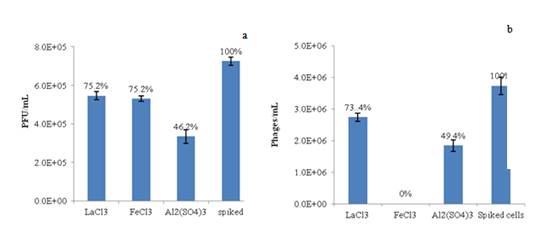Grantee Research Project Results
2011 Progress Report: Rapid Concentration, Detection, and Quantification of Pathogens in Drinking Water
EPA Grant Number: R833840Title: Rapid Concentration, Detection, and Quantification of Pathogens in Drinking Water
Investigators: Hu, Zhiqiang , Riley, Lela K. , Lin, Mengshi
Institution: University of Missouri - Columbia
EPA Project Officer: Aja, Hayley
Project Period: May 1, 2008 through April 30, 2011 (Extended to April 30, 2013)
Project Period Covered by this Report: May 1, 2011 through April 30,2012
Project Amount: $600,000
RFA: Development and Evaluation of Innovative Approaches for the Quantitative Assessment of Pathogens and Cyanobacteria and Their Toxins in Drinking Water (2007) RFA Text | Recipients Lists
Research Category: Drinking Water , Water
Objective:
The objectives of this research are to: (1) evaluate a lanthanum-based colloidal destabilization method to rapidly concentrate pathogens in water; (2) determine the efficiency of fluorescence-based oxygen microrespirometry in differentiating live/dead pathogens; (3) develop and validate a new surface-enhanced Raman spectroscopy (SERS)-based method for pathogen detection and quantification; and (4) improve pathogen detection using modified concentration and molecular detection methods and compare the detection efficiencies to the Environmental Protection Agency's (EPA) existing methods with seeded or unseeded drinking water samples.
Progress Summary:

References:
Journal Articles on this Report : 2 Displayed | Download in RIS Format
| Other project views: | All 6 publications | 5 publications in selected types | All 5 journal articles |
|---|
| Type | Citation | ||
|---|---|---|---|
|
|
Fan C, Hu Z, Mustapha A, Lin M. Rapid detection of food-and waterborne bacteria using surface-enhanced Raman spectroscopy coupled with silver nanosubstrates. Applied Microbiology and Biotechnology 2011;92(5):1053-1061. |
R833840 (2010) R833840 (2011) R833840 (Final) |
Exit |
|
|
Zhang Y, Riley LK, Lin M, Hu Z. Determination of low-density Escherichia coli and Helicobacter pylori suspensions in water. Water Research 2012;46(7):2140-2148. |
R833840 (2010) R833840 (2011) R833840 (Final) |
Exit Exit |
Supplemental Keywords:
Drinking water, exposure, waterborne pathogens, microbiology, monitoring, measurement methods, physical processes, health effects, field-based detection, lanthanum, respirometry, Surface Enhanced Raman Spectroscopy, nanotechnology, biotechnology, RFA, Health, Ecosystem Protection/Environmental Exposure & Risk, Scientific Discipline, PHYSICAL ASPECTS, Water, Health Risk Assessment, Physical Processes, Risk Assessments, Environmental Chemistry, Monitoring/Modeling, Drinking Water, Environmental Monitoring, microbial contamination, E. Coli, virulence factor activity relationships, human exposure, measurement, microbiological organisms, microorganism, measurement , microbial risk assessment, microbial risk management, monitoring, bacteria monitoring, drinking water contaminants, exposure, assessment technology, other - risk assessment, virulence factor biochip, human health risk, detection, exposure and effectsProgress and Final Reports:
Original AbstractThe perspectives, information and conclusions conveyed in research project abstracts, progress reports, final reports, journal abstracts and journal publications convey the viewpoints of the principal investigator and may not represent the views and policies of ORD and EPA. Conclusions drawn by the principal investigators have not been reviewed by the Agency.
